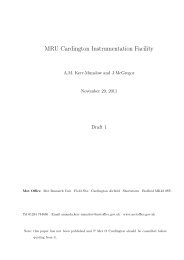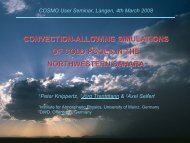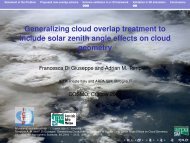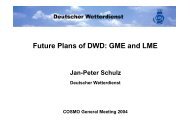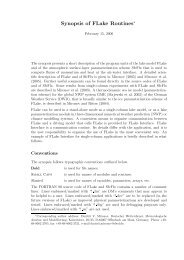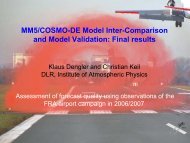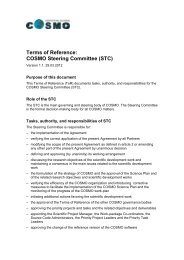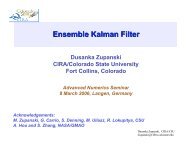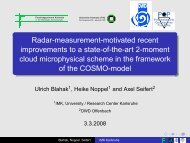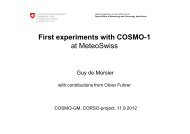Best-member-selection as part of an ensemble based data ... - Cosmo
Best-member-selection as part of an ensemble based data ... - Cosmo
Best-member-selection as part of an ensemble based data ... - Cosmo
Create successful ePaper yourself
Turn your PDF publications into a flip-book with our unique Google optimized e-Paper software.
Eidgenössisches De<strong>part</strong>ement des Innern EDIBundesamt für Meteorologie und Klimatologie MeteoSchweiz<strong>Best</strong>-<strong>member</strong>-<strong>selection</strong><strong>as</strong> <strong>part</strong> <strong>of</strong> <strong>an</strong> <strong>ensemble</strong> b<strong>as</strong>ed<strong>data</strong> <strong>as</strong>similation approachT<strong>an</strong>ja Weusth<strong>of</strong>f 1 , D<strong>an</strong>iel Leuenberger 1 ,Christi<strong>an</strong> Keil 2 , George Craig 21MeteoSwiss, 2 DLRCOSMO/CLM User Seminar, L<strong>an</strong>gen, 09.-11.03.2009
New <strong>data</strong> <strong>as</strong>similation approach: SIRFDriving EPS(SREPS)Assimilation periodtimeCOSMO-DE-EPS<strong>Best</strong>-Member-Selection 1<strong>Best</strong>-Member-Selection 2EnsembleEnh<strong>an</strong>cement/Resampling<strong>Best</strong>-<strong>member</strong>-<strong>selection</strong> <strong>as</strong> <strong>part</strong> <strong>of</strong> <strong>an</strong> <strong>ensemble</strong> b<strong>as</strong>ed <strong>data</strong> <strong>as</strong>similation approach | COSMO/CLM User SeminarT<strong>an</strong>ja Weusth<strong>of</strong>f et al.2
ObjectivesWP1: Evaluation <strong>of</strong> cl<strong>as</strong>sical <strong>an</strong>d spatial metrics for the determination <strong>of</strong>weighting schemes for <strong>ensemble</strong> <strong>member</strong>s (DLR, MeteoSchweiz)WP1.1 Implement spatial metrics <strong>an</strong>d evaluation on selected COPS eventsFQM <strong>of</strong> Keil <strong>an</strong>d Craig (2007), which is already available,SAL (Wernli et al. 2007)fuzzy verification package <strong>of</strong> Ebert (2007).WP1.2 Implement cl<strong>as</strong>sical metrics for conventional observationsWP1.3 Investigate correlation <strong>of</strong> metrics between models <strong>of</strong> differentresolutionWP1.4 Compare object-oriented <strong>an</strong>d cl<strong>as</strong>sical metricsWP1.5 Investigate persistence <strong>of</strong> skill in different metrics <strong>an</strong>d differentmeteorological situations<strong>Best</strong>-<strong>member</strong>-<strong>selection</strong> <strong>as</strong> <strong>part</strong> <strong>of</strong> <strong>an</strong> <strong>ensemble</strong> b<strong>as</strong>ed <strong>data</strong> <strong>as</strong>similation approach | COSMO/CLM User SeminarT<strong>an</strong>ja Weusth<strong>of</strong>f et al.3
ConceptApply cl<strong>as</strong>sical quadratical error me<strong>as</strong>ure for conventional observations:[ y−H ( x)]TR−1[ y−H ( x)]( R2⎧ 1/iji = j= ⎨⎩ 0 else−1 σ)ijIn order to give more import<strong>an</strong>t observations a higher weighting („tuning“),<strong>an</strong> additional matrix A is multiplied to the error covari<strong>an</strong>ce matrix Rcontaining the setting <strong>of</strong> the weights.m = [ y −H ( x)]TAR−1[ y −H ( x)]y = vector <strong>of</strong> observationsH(x) = vector <strong>of</strong> forec<strong>as</strong>tsH = forward operator,H(x) = observation equivalent, calculated from model state xR = covari<strong>an</strong>z-matrix <strong>of</strong> the observation errors, DiagonalmatrixA = additional matrix for the weightings <strong>of</strong> parameters, DiagonalmatrixAij⎧ αii = j= ⎨⎩ 0 else<strong>Best</strong>-<strong>member</strong>-<strong>selection</strong> <strong>as</strong> <strong>part</strong> <strong>of</strong> <strong>an</strong> <strong>ensemble</strong> b<strong>as</strong>ed <strong>data</strong> <strong>as</strong>similation approach | COSMO/CLM User SeminarT<strong>an</strong>ja Weusth<strong>of</strong>f et al.4
Quality me<strong>as</strong>ure m= dist<strong>an</strong>ce <strong>of</strong> model <strong>member</strong> x (k) to observationsm= [ y−H ( x)]TAR−1[ y−H ( x)]~ ( k )( k )i= yi− H ( xd)i =1,...YY = # variables * # stations * # levelsm( k ) ~ ~ k=ii[ ]( k ) T−1( )d AR dk =1,...KK = # <strong>member</strong>m( k )Y= ∑αi=1i~[ ]( k )diσ2ii2m ( k)= D⋅αoptimal weighting α to be determined<strong>Best</strong>-<strong>member</strong>-<strong>selection</strong> <strong>as</strong> <strong>part</strong> <strong>of</strong> <strong>an</strong> <strong>ensemble</strong> b<strong>as</strong>ed <strong>data</strong> <strong>as</strong>similation approach | COSMO/CLM User SeminarT<strong>an</strong>ja Weusth<strong>of</strong>f et al.5
Quality me<strong>as</strong>ure m= dist<strong>an</strong>ce <strong>of</strong> model <strong>member</strong> x (k) to observationsm k)= D⋅α(⎟ ⎟⎟⎟⎟⎟⎟⎟⎟⎟⎟⎟ ⎠⎛m⎜⎜m⎜⎜...⎜⎜⎜⎝ m(1)(2)K⎞⎟⎟⎟⎟⎟⎟⎟⎠=⎛ d1⎜⎜ d1⎜⎜...⎜⎜ ( K⎝d1(1)(2))ddd(1)2(2)2...( K)2d(1)3......( K)Y⎛α1⎞⎜⎜α2⎞ ⎜α3⎟ ⎜⎟ ⎜ ...⎟⋅⎜⎟ ⎜⎟ ⎜⎟ ⎜⎠ ⎜⎜⎜⎝αY<strong>Best</strong>-<strong>member</strong>-<strong>selection</strong> <strong>as</strong> <strong>part</strong> <strong>of</strong> <strong>an</strong> <strong>ensemble</strong> b<strong>as</strong>ed <strong>data</strong> <strong>as</strong>similation approach | COSMO/CLM User SeminarT<strong>an</strong>ja Weusth<strong>of</strong>f et al....dd(1)Y...6
Forec<strong>as</strong>t: COSMO-DE-EPS• High resolution <strong>ensemble</strong> with 20 <strong>member</strong>s, 00 UTC runs• 4 driving models:• Member 1-5 EZMWF• Member 6-10 GME• Member 11-15 NCEP• Member 16-20 UKMO• 5 perturbations <strong>of</strong> model physics• Members 1, 6,11,16 Entrainment rate (entrscv=0.002)• Members 2, 7,12,17 Cloud cover at saturation (clc_diag=0.5)• Members 3, 8,13,18 Laminar layer depth (rlam_heat=50)• Members 4, 9,14,19 Laminar layer depth (rlam_heat=0.1)• Members 5,10,15,20 Turbulent lengh scale (tur_len=150)<strong>Best</strong>-<strong>member</strong>-<strong>selection</strong> <strong>as</strong> <strong>part</strong> <strong>of</strong> <strong>an</strong> <strong>ensemble</strong> b<strong>as</strong>ed <strong>data</strong> <strong>as</strong>similation approach | COSMO/CLM User SeminarT<strong>an</strong>ja Weusth<strong>of</strong>f et al.7
Observations<strong>Best</strong>-<strong>member</strong>-<strong>selection</strong> b<strong>as</strong>ed on st<strong>an</strong>dard observations like Synop(hourly), Radiosondes (6 hourly or less), …First investigation with radiosondes• Variables on pressure levels:• temperature,• relative humidity,• u- <strong>an</strong>d v- wind components• …• Integrated variables:• CAPE• CIN• integrated water vapour (IWV)• …<strong>Best</strong>-<strong>member</strong>-<strong>selection</strong> <strong>as</strong> <strong>part</strong> <strong>of</strong> <strong>an</strong> <strong>ensemble</strong> b<strong>as</strong>ed <strong>data</strong> <strong>as</strong>similation approach | COSMO/CLM User SeminarT<strong>an</strong>ja Weusth<strong>of</strong>f et al.8
Weighting …Seven variablesTemperature T,relative humidity RH,Wind components U <strong>an</strong>d VCAPEIWVCIN21levelssinglelevelsThree level regions1000 – 700 hPa650 – 400 hPa350 – 100 hPa Weightings <strong>of</strong> variables <strong>an</strong>dlevels are multiplied!Initial Weighting everything is set to the same weight 1T RH U V CAPE IWV CIN1 1 1 1 1 1 11000-700650-4001 1 1350-100<strong>Best</strong>-<strong>member</strong>-<strong>selection</strong> <strong>as</strong> <strong>part</strong> <strong>of</strong> <strong>an</strong> <strong>ensemble</strong> b<strong>as</strong>ed <strong>data</strong> <strong>as</strong>similation approach | COSMO/CLM User SeminarT<strong>an</strong>ja Weusth<strong>of</strong>f et al.9
… & EvaluationQ: Do the target quality me<strong>as</strong>ure <strong>an</strong>d our m identify the same best<strong>member</strong>s?1. Correlation between target quality r <strong>an</strong>d mcor=covrr,mσ ⋅σm2. Dist<strong>an</strong>ce between the two quality me<strong>as</strong>ures:r − m Need m (k) <strong>an</strong>d r (k) in the same r<strong>an</strong>ge, e.g. [0,1] in order to determinethe optimal weighting α = [0,1] such thatr− m=r−D ⋅α= minHere: Target quality r = DAS<strong>Best</strong>-<strong>member</strong>-<strong>selection</strong> <strong>as</strong> <strong>part</strong> <strong>of</strong> <strong>an</strong> <strong>ensemble</strong> b<strong>as</strong>ed <strong>data</strong> <strong>as</strong>similation approach | COSMO/CLM User SeminarT<strong>an</strong>ja Weusth<strong>of</strong>f et al.10
Target Quality: DAS• The target quality r <strong>of</strong> the <strong>ensemble</strong> is provided by the quality me<strong>as</strong>ure withrespect to precipitation (radar) the Displacement <strong>an</strong>d Amplitude ScoreDAS (Keil <strong>an</strong>d Craig, 2009)• DAS is b<strong>as</strong>ed on <strong>an</strong> areal image matcher using cl<strong>as</strong>sical optical flowtechnique & h<strong>as</strong> 2 components:• displacement error field DIS• amplitude error AMP (RMS <strong>of</strong> observed <strong>an</strong>d morphed forec<strong>as</strong>t imagery)D maxI 0maximum search dist<strong>an</strong>cecharacteristic intensity<strong>Best</strong>-<strong>member</strong>-<strong>selection</strong> <strong>as</strong> <strong>part</strong> <strong>of</strong> <strong>an</strong> <strong>ensemble</strong> b<strong>as</strong>ed <strong>data</strong> <strong>as</strong>similation approach | COSMO/CLM User SeminarT<strong>an</strong>ja Weusth<strong>of</strong>f et al.11
Target Quality: DASEZMWFGMENCEPUKMO DAS at specifictime DAS, is highlycorrelated with 6-hhourly calculatedme<strong>an</strong>DAS,6-hourly me<strong>an</strong>(forward averaged)DAS,every 6 h(at start time <strong>of</strong>averaging period)<strong>Best</strong>-<strong>member</strong>-<strong>selection</strong> <strong>as</strong> <strong>part</strong> <strong>of</strong> <strong>an</strong> <strong>ensemble</strong> b<strong>as</strong>ed <strong>data</strong> <strong>as</strong>similation approach | COSMO/CLM User SeminarT<strong>an</strong>ja Weusth<strong>of</strong>f et al.12
First Results… investigated period: 08.-16.08.200710738 Stuttgart - Echterdingen14sunshine duratiomcloud coverage [1/8]rain amountrelative humidity100rain sum [mm] <strong>an</strong>d total sunshineduration [h]12108642908070605040302010me<strong>an</strong> relative humidity [%]020070808 20070810 20070812 20070814 200708160Mesoscale forcingConvectionMesoscale forcing<strong>Best</strong>-<strong>member</strong>-<strong>selection</strong> <strong>as</strong> <strong>part</strong> <strong>of</strong> <strong>an</strong> <strong>ensemble</strong> b<strong>as</strong>ed <strong>data</strong> <strong>as</strong>similation approach | COSMO/CLM User SeminarT<strong>an</strong>ja Weusth<strong>of</strong>f et al.13
First Results… investigated period: 08.-16.08.2007… 8 radiosondes within considered DAS area1 DeBilt2 Payerne4 53 N<strong>an</strong>cy4 Schleswig196785 Greifswald6 Emden7 Bergen8 Lindenberg9 Essen1110131610 Meiningen11 Idar-Oberstein12 Stuttgart31213 Kuemmersbruck2151414 Muenchen15 Hohenpeissenberg16 Prag<strong>Best</strong>-<strong>member</strong>-<strong>selection</strong> <strong>as</strong> <strong>part</strong> <strong>of</strong> <strong>an</strong> <strong>ensemble</strong> b<strong>as</strong>ed <strong>data</strong> <strong>as</strong>similation approach | COSMO/CLM User SeminarT<strong>an</strong>ja Weusth<strong>of</strong>f et al.14
Equally weighted variables <strong>an</strong>d levelsmEZMWFGMENCEPUKMOd<strong>as</strong>Maximum in the afternoon,minimum in the morning(new run);Partly clustering <strong>member</strong>swith same driving models<strong>Best</strong>-<strong>member</strong>-<strong>selection</strong> <strong>as</strong> <strong>part</strong> <strong>of</strong> <strong>an</strong> <strong>ensemble</strong> b<strong>as</strong>ed <strong>data</strong> <strong>as</strong>similation approach | COSMO/CLM User SeminarT<strong>an</strong>ja Weusth<strong>of</strong>f et al.15
Scatterplots (m vs DAS)EZMWFGMENCEPUKMO<strong>Best</strong>-<strong>member</strong>-<strong>selection</strong> <strong>as</strong> <strong>part</strong> <strong>of</strong> <strong>an</strong> <strong>ensemble</strong> b<strong>as</strong>ed <strong>data</strong> <strong>as</strong>similation approach | COSMO/CLM User SeminarT<strong>an</strong>ja Weusth<strong>of</strong>f et al.16
Scatterplots (m vs DAS),Individual <strong>member</strong>sR<strong>an</strong>ge <strong>of</strong>correlation…EZMWF0.11 – 0.19GME0.22 – 0.33NCEP0.11 – 0.24UKMO-0.01 - 0.08<strong>Best</strong>-<strong>member</strong>-<strong>selection</strong> <strong>as</strong> <strong>part</strong> <strong>of</strong> <strong>an</strong> <strong>ensemble</strong> b<strong>as</strong>ed <strong>data</strong> <strong>as</strong>similation approach | COSMO/CLM User SeminarT<strong>an</strong>ja Weusth<strong>of</strong>f et al.17
CorrelationIndividual time steps… large variation <strong>of</strong>correlation with time correlation apparentlyhigher for mesoscaledriven days…Mesoscale forcingConvectionMesoscale forcing<strong>Best</strong>-<strong>member</strong>-<strong>selection</strong> <strong>as</strong> <strong>part</strong> <strong>of</strong> <strong>an</strong> <strong>ensemble</strong> b<strong>as</strong>ed <strong>data</strong> <strong>as</strong>similation approach | COSMO/CLM User SeminarT<strong>an</strong>ja Weusth<strong>of</strong>f et al.18
Frequency distributionhistogram <strong>of</strong> normalizedquality me<strong>as</strong>ures:d<strong>as</strong>/max(d<strong>as</strong>) <strong>an</strong>dm/(max(m))same <strong>as</strong> above, but: d<strong>as</strong> x=d<strong>as</strong> 2 PDF become more similar, Decre<strong>as</strong>e in |d<strong>as</strong>-m|<strong>Best</strong>-<strong>member</strong>-<strong>selection</strong> <strong>as</strong> <strong>part</strong> <strong>of</strong> <strong>an</strong> <strong>ensemble</strong> b<strong>as</strong>ed <strong>data</strong> <strong>as</strong>similation approach | COSMO/CLM User SeminarT<strong>an</strong>ja Weusth<strong>of</strong>f et al.19
Sensitivity studies1. VariablesT RH U V CAPE IWV CIN0.5 0.5 0.5 0.5 0.5 0.5 0.51000-700650-4001 1 1350-100Procedure: Set all variables to 0.5, vary each variable from 0to 1.0 in steps <strong>of</strong> 0.1. Level weightings stay 1.RH <strong>an</strong>d CAPE showstrongest (positive)response to weighting<strong>Best</strong>-<strong>member</strong>-<strong>selection</strong> <strong>as</strong> <strong>part</strong> <strong>of</strong> <strong>an</strong> <strong>ensemble</strong> b<strong>as</strong>ed <strong>data</strong> <strong>as</strong>similation approach | COSMO/CLM User SeminarT<strong>an</strong>ja Weusth<strong>of</strong>f et al.20
Sensitivity studies2. LevelsT RH U V CAPE IWV CIN1 1 1 1 1 1 11000-700650-400350-1000.5 0.5 0.5Procedure: Set all levels to 0.5, vary each level from 0 to 1.0 insteps <strong>of</strong> 0.1. Level weightings stay 1.Levels between 650 <strong>an</strong>d 400hPa show strongest (positive)response to weighting<strong>Best</strong>-<strong>member</strong>-<strong>selection</strong> <strong>as</strong> <strong>part</strong> <strong>of</strong> <strong>an</strong> <strong>ensemble</strong> b<strong>as</strong>ed <strong>data</strong> <strong>as</strong>similation approach | COSMO/CLM User SeminarT<strong>an</strong>ja Weusth<strong>of</strong>f et al.21
Combination <strong>of</strong> variables <strong>an</strong>d levels …mT RH U V CAPE IWV CIN0.4 1 0.4 0.6 0.1 0.1 0.11000-700650-4000 1 0350-100d<strong>as</strong>EZMWFGMENCEPUKMO<strong>Best</strong>-<strong>member</strong>-<strong>selection</strong> <strong>as</strong> <strong>part</strong> <strong>of</strong> <strong>an</strong> <strong>ensemble</strong> b<strong>as</strong>ed <strong>data</strong> <strong>as</strong>similation approach | COSMO/CLM User SeminarT<strong>an</strong>ja Weusth<strong>of</strong>f et al.22
Scatterplots (m vs DAS),Individual <strong>member</strong>sR<strong>an</strong>ge <strong>of</strong>correlation…(for equallyweighted)EZMWF0.32 – 0.40(0.11 – 0.19)GME0.39 – 0.53(0.22 – 0.33)NCEP0.25 – 0.31(0.11 – 0.24)UKMO0.31 - 0.38(-0.01 - 0.08)<strong>Best</strong>-<strong>member</strong>-<strong>selection</strong> <strong>as</strong> <strong>part</strong> <strong>of</strong> <strong>an</strong> <strong>ensemble</strong> b<strong>as</strong>ed <strong>data</strong> <strong>as</strong>similation approach | COSMO/CLM User SeminarT<strong>an</strong>ja Weusth<strong>of</strong>f et al.23
Comparison• Equally weighted • Combined weightingT RH U V CAPE IWV CIN1 1 1 1 1 1 1T RH U V CAPE IWV CIN0.4 1 0.4 0.6 0.1 0.1 0.11000-700650-4001 1 1350-1001000-700650-4000 1 0350-100Corr(m,d<strong>as</strong>)0.170.37TOTAL(|d<strong>as</strong>-m|)241.93242.62Corr(m,d<strong>as</strong>²)0.160.36TOTAL(|d<strong>as</strong>²-m|)108.68109.36 Rarely a ch<strong>an</strong>ge in dist<strong>an</strong>ce |d<strong>as</strong> - m|, but incre<strong>as</strong>e in correlation!<strong>Best</strong>-<strong>member</strong>-<strong>selection</strong> <strong>as</strong> <strong>part</strong> <strong>of</strong> <strong>an</strong> <strong>ensemble</strong> b<strong>as</strong>ed <strong>data</strong> <strong>as</strong>similation approach | COSMO/CLM User SeminarT<strong>an</strong>ja Weusth<strong>of</strong>f et al.24
Preliminary Fazit• Radiosondes do give information on best <strong>member</strong>s in terms <strong>of</strong>precipitation forec<strong>as</strong>t (<strong>as</strong> me<strong>as</strong>ured by DAS).• Test with radiosoundings reveal a sensitivity <strong>of</strong> the best <strong>member</strong><strong>selection</strong> with respect to parameter <strong>an</strong>d heights.• The correlation with DAS could be improved by using radiosondes<strong>data</strong> with different weightings for variables <strong>an</strong>d heights.• The correlation between the two quality me<strong>as</strong>ures DAS <strong>an</strong>d m isapparently time-dependent.• The correlations are in the order <strong>of</strong> 0.4, while DAS values at startingtime <strong>of</strong> averaging period are highly correlated with DAS averaged overnext 6 hours the precipitation me<strong>as</strong>ure DAS provides a good b<strong>as</strong>is for the best<strong>member</strong> <strong>selection</strong>. The use <strong>of</strong> st<strong>an</strong>dard observation <strong>as</strong> alternativequality me<strong>as</strong>ure seems to be appropriate.<strong>Best</strong>-<strong>member</strong>-<strong>selection</strong> <strong>as</strong> <strong>part</strong> <strong>of</strong> <strong>an</strong> <strong>ensemble</strong> b<strong>as</strong>ed <strong>data</strong> <strong>as</strong>similation approach | COSMO/CLM User SeminarT<strong>an</strong>ja Weusth<strong>of</strong>f et al.25
Outlook• find suitable combination <strong>of</strong> only a few parameters fromradiosondes <strong>an</strong>d synop stations (e.g. total energy)• determine optimal weighting <strong>of</strong> those parameters withrespect to target quality me<strong>as</strong>ure r• exp<strong>an</strong>d best <strong>member</strong> <strong>selection</strong> to driving <strong>ensemble</strong><strong>Best</strong>-<strong>member</strong>-<strong>selection</strong> <strong>as</strong> <strong>part</strong> <strong>of</strong> <strong>an</strong> <strong>ensemble</strong> b<strong>as</strong>ed <strong>data</strong> <strong>as</strong>similation approach | COSMO/CLM User SeminarT<strong>an</strong>ja Weusth<strong>of</strong>f et al.26
Th<strong>an</strong>k you for the attention!<strong>Best</strong>-<strong>member</strong>-<strong>selection</strong> <strong>as</strong> <strong>part</strong> <strong>of</strong> <strong>an</strong> <strong>ensemble</strong> b<strong>as</strong>ed <strong>data</strong> <strong>as</strong>similation approach | COSMO/CLM User SeminarT<strong>an</strong>ja Weusth<strong>of</strong>f et al.27
<strong>Best</strong>-<strong>member</strong>-<strong>selection</strong> <strong>as</strong> <strong>part</strong> <strong>of</strong> <strong>an</strong> <strong>ensemble</strong> b<strong>as</strong>ed <strong>data</strong> <strong>as</strong>similation approach | COSMO/CLM User SeminarT<strong>an</strong>ja Weusth<strong>of</strong>f et al.28
Reference: Keil, C. <strong>an</strong>d G. C. Craig, 2009: A displacement <strong>an</strong>damplitude score employing <strong>an</strong> optical flow technique, submitted toWea. <strong>an</strong>d Forec<strong>as</strong>ting.<strong>Best</strong>-<strong>member</strong>-<strong>selection</strong> <strong>as</strong> <strong>part</strong> <strong>of</strong> <strong>an</strong> <strong>ensemble</strong> b<strong>as</strong>ed <strong>data</strong> <strong>as</strong>similation approach | COSMO/CLM User SeminarT<strong>an</strong>ja Weusth<strong>of</strong>f et al.29
Calculation <strong>of</strong> variablesIntegrated Water VapourIWV = ∫ ρ dz = ∫ q dzwρq = spezifische FeuchteCAPE, CIN…(max CAPE)<strong>Best</strong>-<strong>member</strong>-<strong>selection</strong> <strong>as</strong> <strong>part</strong> <strong>of</strong> <strong>an</strong> <strong>ensemble</strong> b<strong>as</strong>ed <strong>data</strong> <strong>as</strong>similation approach | COSMO/CLM User SeminarT<strong>an</strong>ja Weusth<strong>of</strong>f et al.30



